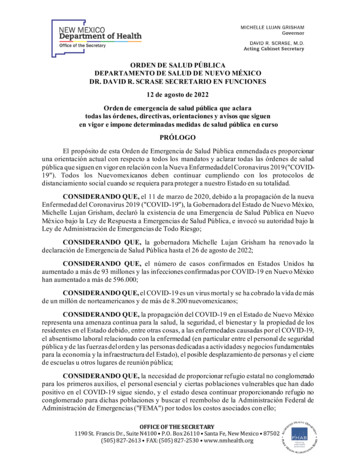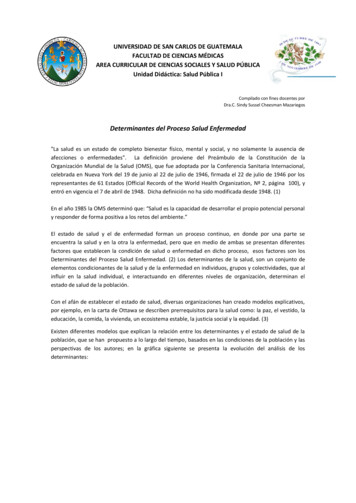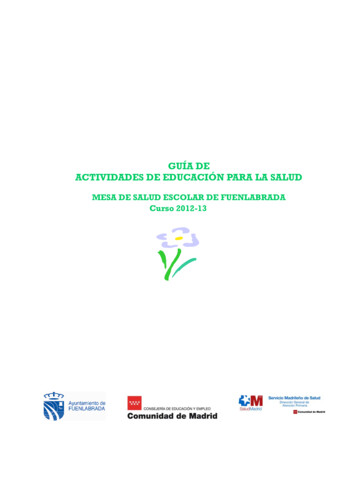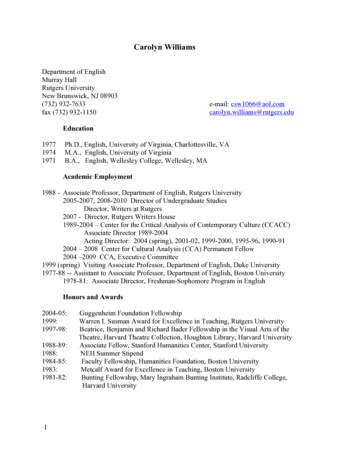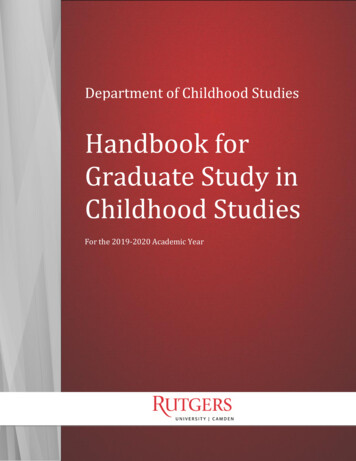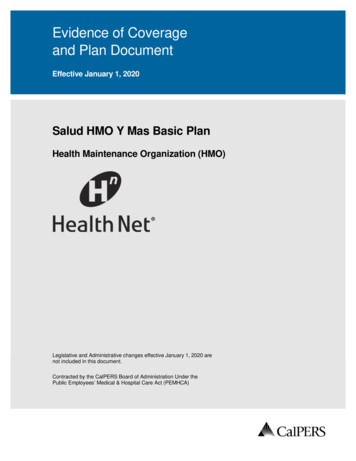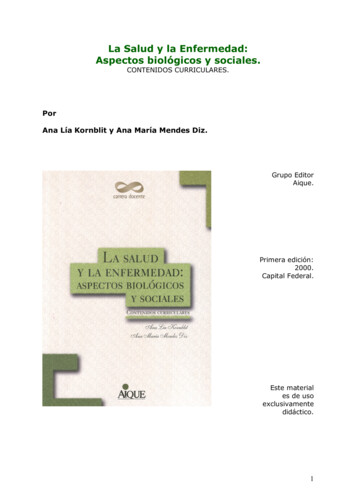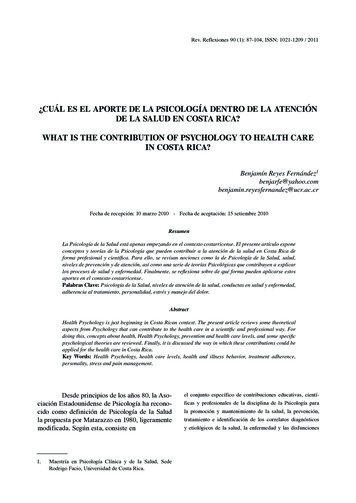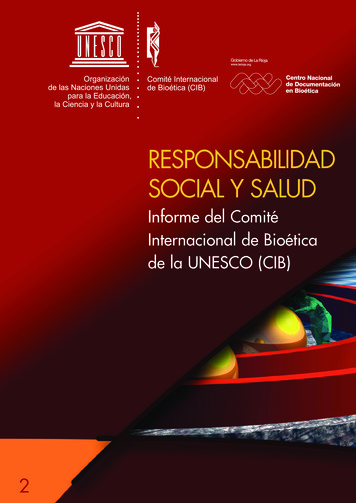
Transcription
“SALUD”Xavier Cortada, 36" x 48", acrylic on canvas, 2003 (www.cortada.com)(Used with permission of the artist.)
About the AuthorsPeter Guarnaccia is Professor in the Department of Human Ecology at the School ofEnvironmental & Biological Sciences and Investigator at the Institute for Health, Health CarePolicy & Aging Research at Rutgers University. His research interests include cross-culturalpatterns of psychiatric disorders, cultural competence in mental health organizations, andprocesses of cultural and health change among Latino immigrants. He has examined mentalhealth among Latinos in the U.S. and in Puerto Rico for two decades, most recently using theNational Latino and Asian American (NLAAS) mental health study funded by NIMH. He has beenshifting his research to Mexico and currently directs one of the International Service LearningPrograms on Culture & Community Health in Oaxaca, Mexico.Karen D'Alonzo is an Associate Professor and the Associate Dean for Nursing Science at theRutgers School of Nursing. She is also the founding Director of the School of Nursing's Center forCommunity Health Partnerships. Using a framework of community based participatory research(CBPR), Dr. D’Alonzo’s scholarship focuses on: 1) bio-behavioral approaches to promotion ofphysical activity and the prevention and management of obesity among diverse groups of womenand 2) the role of acculturation stress and marianismo beliefs as a barrier to healthy lifestylesamong Hispanic immigrant women. Her NIH-funded research projects have made use of laycommunity health workers/promotoras de salud to deliver health promotion interventions in theimmigrant Latino community. Dr. D’Alonzo has also initiated academic and research partnershipswith the nursing programs at the State University of Oaxaca (SUNEO).Sandra E. Echeverría is an Associate Professor and Director of the Community Health EducationProgram at the School of Urban Public Health at Hunter College, CUNY School of Public Health.Dr. Echeverría is a social epidemiologist whose research seeks to understand how neighborhoodcontexts, poverty, and immigrant status pattern physical activity, diabetes and smoking inracially/ ethnically diverse populations. She has conducted quantitative and qualitative projectsin the city of Newark, NJ, where she investigated exposure to neighborhood violence and itsimpact on youth physical activity in a community sample, and explored community members’perceptions of the role of parks and the surrounding neighborhood for promoting health. In morerecent work, she has implemented community-engaged projects to increase physical activityamong Latinos diagnosed with diabetes.
Table of ContentsAcknowledgments. iIntroduction: Culture of Health Framework . 1Cross-Cutting Themes in the Latino Culture of Health . 2Diversity in Latino Communities . 2Concepts of Health. 5Latino Health Paradox & New Perspectives on Latino Health . 6Dimensions of the Culture of Health Specific to Latino Communities . 8Social & Economic Contexts: Neighborhoods. 8Social & Economic Contexts: Housing . 9Neighborhoods & Health Behaviors . 9Employment . 10Physical Environmental . 11Health Behaviors to Promote a Culture of Health . 12Obesity, Diabetes & Cardiovascular Disease: Critical Health Issues . 12Health Behaviors: Substance Use & Sexual Health. 13Clinical Care: Access to Health Care Services . 15Implementing the Culture of Health: Capacity of Community Organizations. 18Priorities for Funding . 19References . 21Appendix . 29
AcknowledgmentsWe would like to acknowledge funding from the New Jersey Health Initiatives program of theRobert Wood Johnson Foundation for support of the development of this White Paper on“Building a Culture of Health for Latinos in New Jersey.”We would like to acknowledge Anindita Fahad (Rutgers School of Public Health) andJennifer Rodriguez Rutgers School of Nursing) for their excellent research assistance to thisproject. They showed great initiative in identifying important new research on the topics coveredin this White Paper.We would like to thank four reviewers who carefully read and provided comments on thedraft version of this paper. They are Steven Levin (Medical Director, Eric B. Chandler HealthCenter); Mariam Merced (Director of the Health Promotions Office, Robert Wood JohnsonUniversity Hospital); Frances Munet-Vilaro (Associate Professor, Rutgers School of Nursing); andMaria Soto-Greene (Vice Dean and Director, Hispanic Center of Excellence, Rutgers New JerseyMedical School). I would also like to thank Linda Melamed, my wife, for her careful editorialcomments and insightful suggestions for strengthening the paper. At the same time, the contentsof this paper are the sole responsibility of the authors.Finally, we would like to acknowledge Xavier Cortada, who generously allowed us to usehis painting “Salud” that captures the themes of this White Paper so beautifully.iRutgers Center for State Health Policy, June 2016
Building a Culture of Health with Latinos in New JerseyPeter Guarnaccia, Ph.D., Karen D’Alonzo, Ph.D., and Sandra E. Echeverría, Ph.D.Introduction: Culture of Health FrameworkThe Culture of Health is an emerging framework developed by the Robert Wood JohnsonFoundation (Plough 2015) to stimulate broader thinking about the meanings of health in thecommunity and the factors that produce good health (See Figure 1 in the Appendix, p. 30). Oneof the goals of promoting the Culture of Health Framework is to move our thinking about healthbeyond focusing only on health care systems to thinking about all the ways the social and culturaldimensions of how people live their lives affect their health (the social determinants of health).If we think about health in this expanded way, then actions to promote healthier individuals andcommunities must be framed much more broadly than simply gaining better access to healthcare, though access to care remains a critically important issue. The Culture of Health Action Plan(See Figure 2, p. 31) has the following key components: making health a shared value; fosteringcross-sector collaboration to improve well-being; creating healthier, more equitablecommunities; and transforming health and health care systems (Plough 2015).As we think about these dimensions of promoting health with Latino communities, itbecomes clear that we need: To take seriously issues of Latino diversity nationally and locally To place different Latino groups in their historical context, especially their histories ofmigration and settlement To understand how the social and physical environments where Latinos settle in NewJersey affect their health To identify how Latinos’ health behaviors and responses to health educationinterventions may differ from other ethnic/racial groups To assess how Latinos’ access to and interactions with health care systems shape healthoutcomes.In this White Paper, we address these issues and suggest ways that organizations andcommunities implementing the Culture of Health Framework might adapt their approaches tothe diversity of Latino communities in New Jersey.Building a Culture of Health with Latinos in New Jersey1
Cross-Cutting Themes in the Latino Culture of HealthDiversity in Latino CommunitiesWhen we think about Latino communities in the U.S. and New Jersey we need to be aware ofissues of diversity within diversity (Guarnaccia et al. 2007). As of 2014, there were 55 millionLatinos in the U.S., making up approximately 17% of the U.S. population. The Latino populationin the U.S. is of diverse national origins, with people of Mexican origin making up 64% of thepopulation; Puerto Ricans 9.5%; Cubans, Salvadorans and Dominicans between 3–4% each; andmany other Central and South American groups accounting for smaller percentages (NationalInstitute for Latino Policy 2015). These percentages are based on official U.S. Census figures andunderrepresent the number of undocumented Latinos in the U.S. While these numbers reflectthe total population of Latinos in the U.S., the proportions and distributions of Latinos are quitedifferent at the state and local levels.New Jersey’s population is 18% Latino, making it the largest ethnically diverse group inthe state. New Jersey’s Latino population has a somewhat unique profile compared to nationaldata, with Puerto Ricans being the largest group (434,000), followed by Mexicans (218,000),Dominicans (198,000), Colombians (102,000), Ecuadorians (100,500), Cubans (83,000), Peruvians(76,000) and Salvadorans (57,000) (Wu 2011). It was not too long ago that Cubans were thesecond largest Latino group, but the aging of the population and outmigration of Cubans toMiami coupled with the rapid rise of other groups make Cubans less prominent today. In truth,all of Latin America can be found in New Jersey.Latinos are not evenly divided across the state; specific groups concentrate in certaincounties and communities (See Maps 1 & 2, pp. 32–33). Puerto Ricans are most heavilyconcentrated in Hudson and Essex counties and still maintain a presence in the city of Vinelandin South Jersey; Mexicans in Passaic and Middlesex; Dominicans in Passaic and Hudson counties;Colombians in Bergen and Union; and Cubans in Hudson County.When we look at the NJ County Health Rankings (University of Wisconsin PopulationHealth Institute 2015), most of the counties where Latinos are most populous are in the bottomhalf of the state county health rankings (See Maps 3 & 4, pp. 34–35). Exceptions are Bergen,Middlesex and Union counties. There are multiple factors that go into the County HealthRankings, including life expectancy, health status, health behaviors, clinical care, social andeconomic factors and the physical environment. Overall, these data tell us that Latinos live incounties where there are a number of factors that put their health, broadly defined, at risk.The implications of Latino diversity in New Jersey are that when we think of implementingthe Culture of Health at the community level, as it is being done in the New Jersey HealthInitiatives 2015 programs, different communities will have very different mixes of Latinos withtheir own histories and cultures and they will face different levels of health challenges. There are2Rutgers Center for State Health Policy, June 2016
several reasons why this diversity is important and why these factors have important impacts onhealth status and access to health care.Different Latino groups and their countries of origin have very different histories ofrelationships with the United States that are critical to understanding the different migrationpatterns and citizenship statuses of Latino groups. Puerto Rico was annexed to the U.S. in 1898after the Spanish American War and all Puerto Ricans were made U.S. citizens in 1917 in order tofight in World War I. Puerto Ricans have been migrating to New Jersey for many decades, somecoming first to New York City and then moving to New Jersey for work and better livingconditions. Some came directly to South Jersey to work on farms through special laborarrangements between the governments of Puerto Rico and New Jersey and many still live incommunities like Vineland. There are many multi-generational Puerto Rican families in NewJersey. In recent years, there has been a resurgence of Puerto Ricans moving to the mainland dueto the economic problems on the Island.Cubans started coming to New Jersey in large numbers after the 1960 Cuban Revolution;New Jersey was the second most frequent destination after Miami. Cubans were greatly aided toattain citizenship and translate their skills to jobs in New Jersey through special refugee programsand thus have attained higher social status than other Latino groups. Different waves of theCuban migration have had different experiences of incorporation into the U.S.; in particular, the1980’s “Marielitos” were less welcomed because they were poorer and darker-skinned thanprevious Cuban migrants.Dominicans have come to escape political strife and economic hardship on the island formany years, but they did not receive the special treatment that Cubans did. Some Dominicanshave flown to Newark Airport with tourist visas and then overstayed those visas. OtherDominicans cross to Puerto Rico on precarious boats and then make their way to the U.S.mainland. Mexicans more typically cross the U.S.-Mexico border without documents and thenmake it to New Jersey travelling across the U.S. They come to find work and reunite with family.Central Americans also often travel through Mexico following similar paths to Mexicanimmigrants. South Americans have diverse patterns of migration. The journeys of those fromCentral and South American can be quite costly and dangerous and often involve traumaticexperiences along the way. These different paths to New Jersey imply different experiences ofhardship and trauma in the migration process and different contexts of reception once arrivingto New Jersey communities.Because of marked differences in educational opportunities in their home countries,different reception of immigrants in New Jersey, and different levels of authorization to be in theU.S., different Latino groups and individuals occupy different occupational sectors of theeconomy, have different socioeconomic statuses, and different levels of protection in their jobs.It is important to assess these factors in beginning to work with particular Latino communities inNew Jersey.Building a Culture of Health with Latinos in New Jersey3
Citizenship status also varies widely across groups. All Puerto Ricans are citizens, as aremost Cubans; many Dominicans and South Americans become naturalized several years afterthey arrive to the United States. While in the Southwestern U.S, Mexicans have multiplegenerations who have lived in the U.S. and are citizens, in New Jersey, Mexicans and CentralAmericans are recently arrived and have the largest number of undocumented individuals of allLatino groups. Given the large presence of Puerto Ricans in New Jersey in multi-generationcommunities, the majority of Latinos in New Jersey are U.S. citizens, a fact that is oftenoverlooked.Many Latinos have problematic relationships with the legal system due to undocumentedstatus and related discrimination against Latinos in New Jersey and nationally. Some of the biasin the legal system results in longer prison sentences for Latinos, causing extended familyseparations. In their work environments, many Latinos lack access to legal representation todefend their rights as workers. This is particularly true for undocumented Latinos, of whom thereare approximately 420,000 in New Jersey (Hoefer, Rytina, and Baker 2012). The undocumentedLatinos mostly work in hazardous jobs and have great difficulties filing for disability from workrelated injuries. Lack of citizenship prevents Latinos from seeking help from police in domesticviolence cases, reporting unsafe conditions to housing inspectors, and highlighting dangerouswork conditions. All of these legal issues resonate with various health vulnerabilities that wediscuss further in subsequent sections.It is important to recognize the cultural diversity among Latino groups and how thesefactors affect health and health care access. All Latinos share African, Indian and Spanish originsto differing extents. Different countries have different mixes of these origin groups that affectlanguage, religion, foodways, music, and other important cultural features. There are largepopulations of both Spanish-dominant individuals in New Jersey and bilingual individuals whospeak English and Spanish due to multi-generational Latino families. Among Mexican immigrantsin New Jersey from the large southern states of Oaxaca and Puebla, there are people from Indiancommunities, some of whose first languages may be an indigenous language rather than Spanish.While many Latinos are Catholic, Protestant religions have made major inroads in Latin Americaand among Latino communities in the U.S. Caribbeans may practice a mix of spiritual religionsand Catholicism that integrates African and Spanish traditions in new ways in the forms ofEspiritismo and Santeria. Diets are very different among Latino groups depending on their regionof origin. Caribbean Latinos’ diets are based on rice, beans, chicken and fish. Mexicans andCentral Americans have diets based on various kinds of corn tortillas, beans, and meats. In SouthAmerica, foodways reflect different indigenous crops, such as the potato, as well as Europeaninfluences, particularly Spain and Italy, but also German and Asian influences. If we are to takeseriously “culture” in the Culture of Health, all these cultural and social issues need to be takeninto account in developing community initiatives to promote and improve the health of differentLatino groups.4Rutgers Center for State Health Policy, June 2016
Concepts of HealthAn important step in implementing the Culture of Health and making health a shared valueamong New Jersey Latinos is to understand what “health” means. In a series of focus groups witha diverse group of Latinos in several communities in New Jersey and New York, Martinez andGuarnaccia (2007) explored what it meant to be able to live a “good life” [una vida buena] andto be able to function in and contribute to society. In reviewing these findings, they highlightedwhat health means to Latinos. Given the diversity of Latinos in these focus groups, it was strikinghow similar the ideas of health were across Latino groups; Latinos appeared to share values abouthealth among themselves, but had potentially important differences in the meanings of healthcompared to other ethnic/racial groups. There was a strong emphasis on being able to live a“tranquil life” [una vida tranquila]. To better understand this concept, participants elaborated onwhat they meant by a “good life.”Para mí una buena vida sería llevar una vida de tranquilidad, sentirse con un pocode salud, que es lo principal, y. sentirse para mi bienestar con su familia unida yvivir tranquilo. [A good life would be living a tranquil life, being in good health,that’s the most important to feel a sense of well-being about my family’s unityand to live peacefully.] (20)In many of the focus groups, ideas about the centrality of social relationships, especially familyrelations, emerged as keys to health and a good life. These ideas fit with epidemiological findingsabout the importance of social relationships to maintaining health.Para mí la buena vida sería una buena unión familiar y poder compartir con losdemás cualquier necesidad que haya. [For me a good life would be to have goodfamily unity and to be able to share with others whatever necessity there mightbe.] (20)Participants linked health to staying away from “vices,” particularly not abusing alcohol or drugs.In addition, one of the key roles of the family is to protect and nurture children; one ofthe major challenges for Latino immigrants is to protect and support their children in the complexand difficult transition to the United States. For some Latino immigrants, especially from Mexicoand Central America, families experience long periods of separation because parents come to theU.S. first to find work and establish a home. Both the separation and subsequent reunificationhave resulted in multiple stressors. Families, especially those coming from rural areas in theirhome countries, often fear that their children will not be safe in the urban centers in the U.S.where many Latinos live.Para mí la buena vida es conservar las amistades y creer en Dios, alejarnos devicios y mantener nuestros hijos fuera de peligro. [For me, a good life ismaintaining friendships and believing in God, staying away from vices and keepingour children out of danger.] (20)Building a Culture of Health with Latinos in New Jersey5
Health is also intimately tied to spirituality; to believing in and seeking God’s protection in life. Inthinking about implementing the Culture of Health framework among Latinos in NJ, these broadideas about health need to be incorporated within this framework.Latino Health Paradox & New Perspectives on Latino HealthA key concept in thinking about the Culture of Health for Latinos is the “Latino Health Paradox”(Abraído-Lanza, Chao, and Flórez 2005; Abraído-Lanza et al. 1999; Markides and Eschbach 2005;Morales et al. 2002; Taningco 2007). Simply stated, the Latino Health Paradox is the finding thatimmigrant Latinos have better health than U.S. born Latinos, and in many cases better healththan other U.S. groups, including European Americans. The reason this is a paradox is that Latinoimmigrants tend to be poorer, have lower levels of education, and worse access to health carethan these comparison groups; these are all factors that correlate with worse health outcomesmore broadly (Morales et al. 2002). Latino immigrants have also experienced many of thestresses of the migratory process itself. So the expectation is that immigrant Latinos would haveworse health than U.S.-born Latinos or other groups in the U.S. This health paradox cuts across anumber of health and mental health issues as well as overall mortality. Yet, when one exploresthe Latino Health Paradox more fully it becomes quite complicated.The Latino Health Paradox has been most clearly documented for Mexican immigrants,by far the largest group of immigrants in the U.S. Puerto Ricans do not experience a healthparadox, in large part because their Island has already been transformed by the U.S. and they donot travel the same social and cultural distances in coming to the mainland U.S. as other Latinogroups. Other Latino groups show a much more mixed picture. Health issues such as depression,substance abuse, adverse pregnancy and birth outcomes, high blood pressure, cancers andoverall mortality show a particularly strong health paradox pattern among Latinos, whereimmigrant Latinos have surprisingly low levels of these problems compared to U.S.-born Latinos.While the literature has been quite convincing in documenting the Latino Health Paradox,especially for Mexican immigrants, it has been less successful in explaining the source of thedifferences. One set of explanations revolves around health behaviors. Immigrant Latinos exhibitvery low rates of smoking and substance abuse, especially among women, and higher levels ofphysical activity, though not leisure-time exercise (Abraído-Lanza, Chao, and Flórez 2005). Somedietary practices, around pregnancy for example (Galvez 2011), also appear to be healthier forimmigrants. Family support and solidarity has also been identified as an important culturalvariable that protects the health of immigrant Latinos (Unnatural Causes 2008).Some studies have suggested that as Latinos age, they return home, taking the sickermembers of the population away from the U.S. leading to undercounting of deaths (Markidesand Eschbach 2005). However, this phenomenon, sometimes called the “salmon bias”, has beenshown to be an unlikely explanation of mortality differences, especially for groups for whomreturn migration is unlikely (e.g., Cubans) or groups where health statistics are collected in the6Rutgers Center for State Health Policy, June 2016
U.S. and abroad (e.g., Puerto Ricans) (Abraído-Lanza et al. 1999). Moreover, all these studies findthat the longer Latinos have been in the U.S., and especially by the second generation, thesehealth advantages disappear and Latinos’ health is worse than European Americans across manyimportant health categories.Recent studies have raised some questions about the Latino Health Paradox, althoughthese tend to weaken, rather than eliminate the immigration effect (Barcellos, Goldman, andSmith 2012). For example, newer studies argue that because of the low access to health care orthe use of emergency departments that only focus on acute problems, many immigrant Latinoshave undiagnosed or undertreated health problems that appear to make their health appearbetter than it is. Barcellos and colleagues (2012) used the National Health and NutritionExamination Survey that included a large over-sample of Mexican Americans. They found thatself-reported diabetes and hypertension was significantly lower among Mexicans than the levelsof these health issues uncovered in these same people when they went for the clinical part ofthe study. Thus, access to health care, a challenge for undocumented Latino immigrants, is criticalto both understanding health patterns and maintaining health.Still other researchers suggest that the health paradoxes observed may vary whenexamined within broader systems of socioeconomic disadvantage and racial/ ethnic stratificationin the U.S. (Echeverría et al. 2013). For example, although Latino immigrants may retain culturalpractices and belief systems that may be beneficial to health, they often face language barriersin accessing care, live in impoverished neighborhoods, participate in low-wage and hazardousoccupations, and have one of the worst educational outcomes of all racial/ ethnic groups in theU.S. (Kandula, Kersey, and Lurie 2004; Malmusi, Borrell, and Benach 2010). Low levels ofeducation affect literacy in Spanish and English, and also result in low levels of health literacy. Inrecent work by Echeverría and colleagues (2013), the authors showed that educationalattainment and nativity status increased risk for disease more than expected if these exposuresacted independently, suggesting that education and birth place act synergistically and shouldsimultaneously be considered in public health approaches.There is also increasing evidence indicating that early life experiences influence thedevelopment of adult health outcomes and that the apparent health advantage observed amongimmigrant Latinos diminishes or disappears across generations due to early life stressorsexperienced by the first generation that “imprint” risk for subsequent generations (Fox et al.2015). Thus, social factors are important determinants of health that need to be carefullyincluded in research studies to avoid underestimating the increased disease risk Latinos face.These findings highlight important implications of the Latino Health Paradox forimplementing the Culture of Health among Latinos in New Jersey. As William Vega, a prominentmedical sociologist at the University of Southern California has often said, entrance into the U.S.should come with a warning – “Caution: Coming to the U.S. may be dangerous to your health!”If Latinos arrive healthy and get sicker the longer they are here, then preventive interventionsBuilding a Culture of Health with Latinos in New Jersey7
with the Latino community are especially important. The Culture of Health perspective impliesthe need to work across varied sectors to more comprehensively address the multiple healthchallenges and barriers faced by Latinos, and by inference to harness existing communitystrengths to prevent the deterioration of health over time. Organizations and communities inNew Jersey can play important roles in preventing health declines through a series of actionssuggested by the Culture of Health.KEY MESSAGES: CROSS-CUTTING THEMES IN LATINO HEALTH Focus on preventive interventions to reverse the trend of health declinesamong Latino immigrants with longer duration in the U.S. Ensure that interventions are tailored to the unique needs of specific Latinogroups and build on the cultural strengths of those groups. Strengthen support systems for newly arrived immigrants and Latino families,especially Latino children who face acculturation stressors early in life andcarry risks into adulthood. Engage in collaborative, multi-sector work with community coalitions toadvocate for community resources and maximize population health forLatinos.Dimensions of the Culture of Health Specific to LatinoCommunitiesSocial & Economic Contexts: NeighborhoodsThe places where people live, work and play are recognized as important determinants of health.In general, Latinos tend to settle in areas with a high concentration of other Latinos (also knownas ‘ethnic enclaves’) and live in neighborhoods often characterized by poverty, unemploymentand crime (See Maps 1–4, pp. 32–25). One particular feature of imp
with the nursing programs at the State University of Oaxaca (SUNEO). Sandra E. Echeverría is an Associate Professor and Director of the Community Health Education Program at the School of Urban Public Health at Hunter College, CUNY School of Public Health. Dr. Echeverría is a social epidemiologist whose research seeks to understand how .

